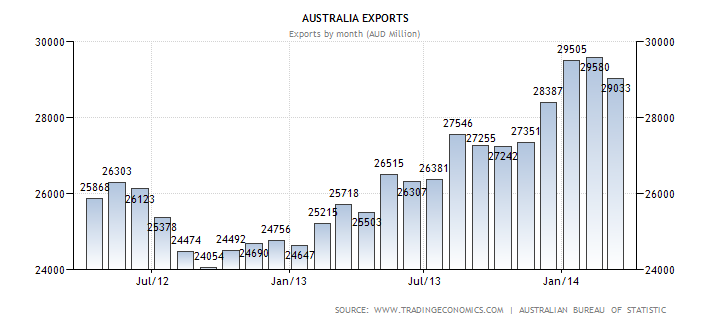Yes, the trade surplus for March dipped to $731 million, down from a surplus of $1.257 billion in February and market forecasts of a figure of around $1 billion.
But that was not such a shock or a disappointment as some in early market reports implied.
The Aussie dollar dipped briefly on the news at 11.30 am, then recovered back to more than 92.80c ahead of the monthly Reserve Bank interest rate decision.
That saw no change, as expected, and the dollar climbed back over the 93c level, dipped back to 92.80c, again, but then jumped to trade around 93.60 in late US trading overnight.
It was a rare, volatile day of trading for the currency which had been in a narrow band at just under 92.80 US cents for several days.
In fact the trade data was pretty good given the slowdown in China and some other key markets for Australia such as India and Japan.
.png)
So despite the gloom and doom about the adverse impact of the fall in our terms of trade, and the higher dollar, the impact has been more modest than many had forecast.
In fact the trade data for March shows the country’s exporters are adjusting to the lower global prices (by boosting export volumes of iron ore and coal) and the dollar (by increasing more complex types of exports) although exports of manufactured goods will come under pressure from 2016 onwards as the car companies stop manufacturing and their limited exports.
Iron ore and coal exports held up in March, especially to China and Japan (and they continued to hold up in April as well, to China in particular).
That’s despite the gloom among many commentators and investors about our exposure to China, where the building industry is weakening.
Those fears will get another run tomorrow when the April Chinese trade data will be released.
Any poor performance by exporters will again have some analysts forecasting a crunch for China and Australia.
But so far the reality has been different, and despite the clear slowing in the Chinese economy, exports from Australia have maintained their frenetic growth in the first few months of this year and hit a record in March.
In fact it produced a trade surplus of around $2.7 billion for the quarter, seasonally adjusted, which was some $3.7 billion better than the revised December deficit of $973 million, which was revised from a surplus of $82 million.
The Australian Bureau of Statistics said exports dipped 2% to just over $29 billion, seasonally adjusted, while imports were flat at $28.3 billion.

The data shows exports to China have hit all-time highs, driven by coal and iron ore exports. They rose to $US9.513 billion from $7.402 billion in March 2013.
That was head and shoulders above the performance in all other export markets, and no doubt will raise concerns about our exposure to the Chinese economy.
Well, that exposure has been there for the best part of a decade, and it has been getting more pronounced, and commentators have been getting more worried and stepping up their henny penny forecasts of doom and gloom.
And so far, the sky hasn’t fallen in.
The data shows that LNG exports are up 20% in value so far this financial year, and that will grow next year and into 2017.
In its analysis the ABS produced figures that should ease the fear among the doom and gloom merchants about the impact of weak global iron ore prices.
Australian companies are stepping up shipments to try and offset the price slide. Australian iron ore is high quality and is preferred by many steel makers because of its high yields.
Australia is also much closer to the key Asian buyers in China, Taiwan, Japan and South Korea than rival producers in Brazil
The ABS said the volume of shipments of lump iron ore (liked by non-Chinese steel mills, although some Chinese mills are now buyers) rose 6%, with China lifting purchases 9% and South Korea 28%. Shipments to Japan fell 17%.
Export volumes of iron ore fines (favoured in China) jumped 21%, with Chinese purchases up 27%, South Korea up 12%, while Taiwanese purchases were off 35% (but on low tonnages).
Hard coking coal exports rose 23% in volume terms (the value was up 2%), soft coking coal exports were up 12% (prices were down 2%), but exports of thermal coal fell 12%, with prices down as well.













